If I had infinite amounts of cash, I’d probably drop a fair amount of it on oddly shaped crystals, scented candles, and tarot/oracle cards.
As it is, I currently only have three tarot decks and one set of oracle cards, and considering I’m still very much a tarot novice, I don’t really need any more right now. Regardless, there are quite a few decks on my wish list (like the Lord of the Rings Tarot, the Gaian Tarot, and the Memento Mori Oracle). Professional card slingers and those that are far more experienced than me often talk about the “energy” of a deck, and after a couple years of using tarot cards and expanding my collection a little bit, I totally get that. Of the few that I do use, each has its own unique personality, and I definitely find myself choosing certain decks for certain moods.
For instance, when I’m in a… shall we say, mystical mood, I often find myself turning to the wonderfully vibrant and trippy Starman Tarot for some wisdom from the great Pop-God David Bowie.
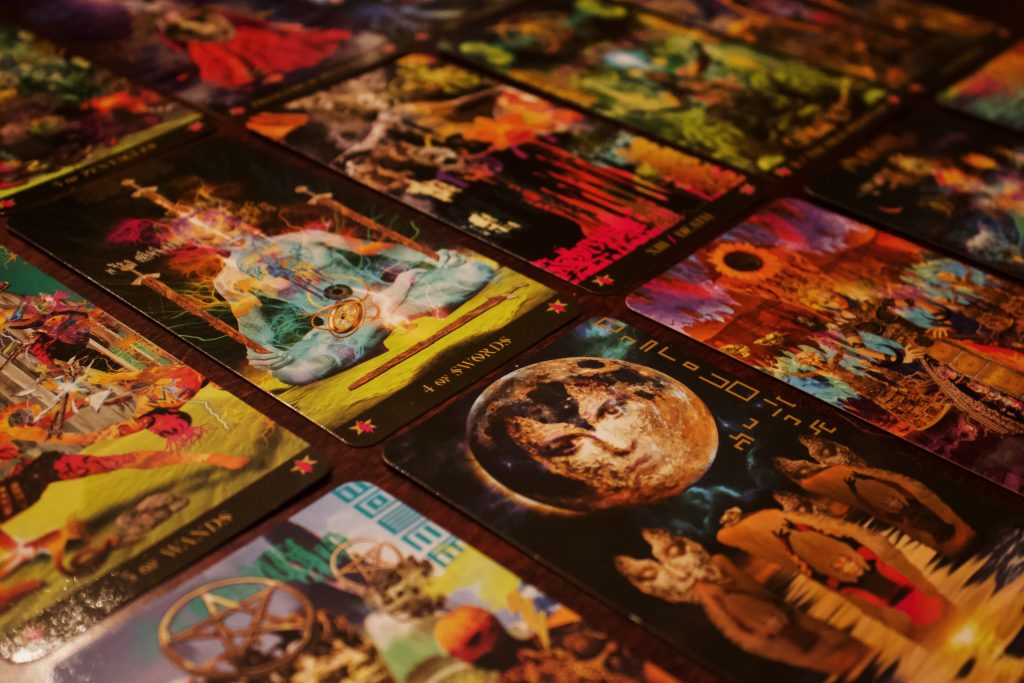
I think a lot of people who don’t really know much about tarot assume that it’s basically just for attempting to predict the future. And while of course divination is certainly an important aspect of tarot, it’s not the only thing that it can be used for. There are so many different uses for tarot and oracle cards that go way beyond future telling.
As I’ve written about in previous posts, when it comes to things like the Spirit world, deity, magic, and divination, I’m not necessarily a whole-hearted “believer.” There is a part of me, that rational, scientifically-minded part of me, that knows that “objective” reality just doesn’t work that way.
Same goes for tarot—when I pull cards, there is a part of me that knows their only significance are the meanings that I ascribe to them. In other words, I get that there is no external force or divine power leading me to choose certain cards over others, or attempting to impart some kind of message on me.
BUT, as I’ve also explained elsewhere (like in the first post in this series on skeptical witchcraft), there is also an integral part of me (you could call her my inner witch, or mystic perhaps) that totally does believe in the reality of magic, Spirit, and the powerful messages that can come through something like tarot cards.
In other words, I am both a skeptic and a believer.
How? Because I don’t think that these two worldviews need to be mutually exclusive.
The skepticism of my everyday, mundane life exists in a different paradigm or framework of reality than my magical life. And though starkly contrasted, these two frameworks are never entirely separate. Rather, the are constantly converging, flowing into one another and playing off each other, making me the walking contradiction, the unity of opposites—the “skeptical witch” that I am.
So, here I want to outline a few of the ways that I use tarot cards as both skeptic and believer.
Skeptical Tarot
1. Psychological Exploration
The first way that I use tarot and oracle cards as a skeptic is for self-exploration and psychological analysis. Tarot cards are incredible in their ability to reveal the inner workings of the mind, and can be an excellent tool for bringing subconscious matters to the surface.
The archetypes found in tarot cards (particularly the major arcana) are comparable to Jungian archetypes—figures of the collective unconscious that we use to structure stories about ourselves and the world around us. Understanding how we think about particular archetypes can be important for figuring out how we relate to the world, and tarot can be instrumental in this process of self-discovery.
Many alternative spiritual psychotherapists use tarot cards when working with clients, and psychologist Dr. Art Rosengarten has even written a book on the various ways in which tarot could be used as a powerful supplemental tool in mainstream psychotherapy. For Rosengarten, tarot can be used to open up the mind beyond the ego in order to explore the dimensions of intuition and emotion that lie beneath the surface.
Personally, though I have zero training in psychology (or the art of tarot!) I use the cards to explore the inner depths of my own mind, particularly when I feel the need to bring some light to a situation, or figure out how I’m really feeling about something. Depending on the importance of whatever this may be, I’ll either pull just one or two cards, or do a larger, more planned out spread. Typically, when I’m drawing cards for psychological exploration, I’ll pull two cards, one to represent the flip side of the other. For instance, the left path versus the right path, the right brain versus left brain, heart versus head, black versus white. If I pull a third card, it will be for clarification, or as a counter to dichotomous ways of thinking.
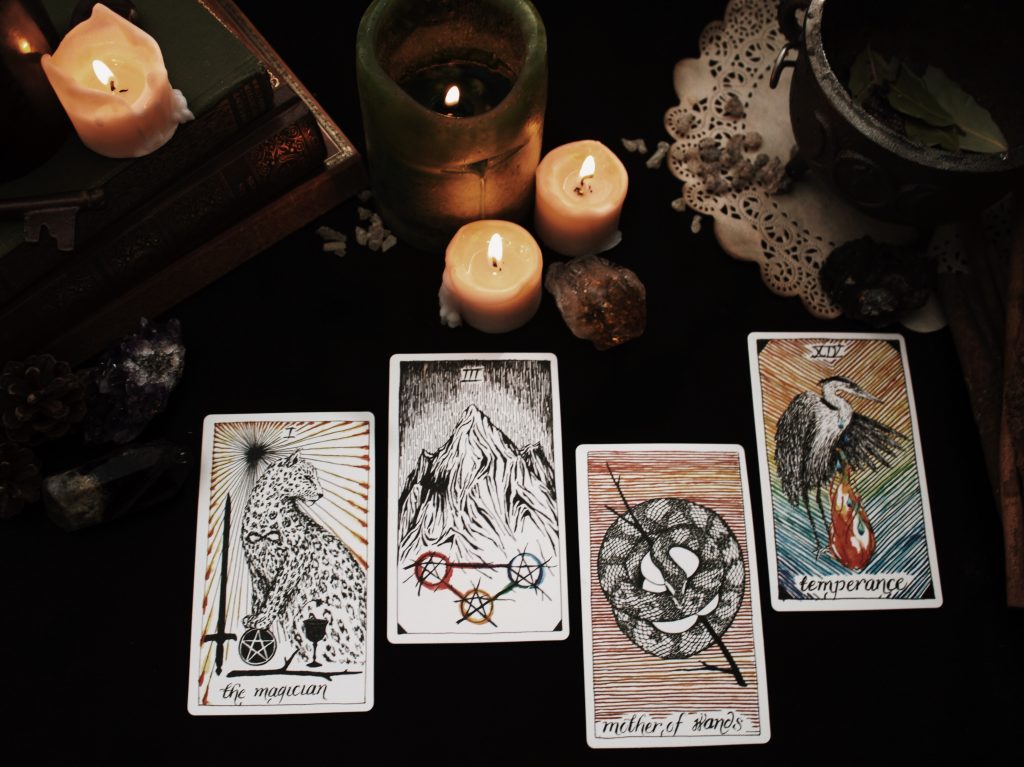
2. Shadow Work
As a component of this self-exploration, I also sometimes use tarot cards specifically for shadow work. Because of the very intense and often uncomfortable nature of shadow work, it’s often hard to jump right into it. Here, I find that tarot can be a helpful starting point for tackling some of those inner demons.
Sometimes, the cards bring up difficult truths that we have to face. If nothing else though, they can at least provide a writing prompt for easing into the work that will hopefully begin to guide you through the shadows to uncover deeper self-knowledge.
I’ve used a few spreads that I’ve found online for shadow work, such as Kelly-Ann Maddox’s spreads, but typically I just focus on whatever issue I’m presently working on, or open myself up to whatever it s that I need to learn, draw cards one at a time, and just go from there.
3. Journaling
Similar to introspection and shadow work, one of the key things that I use tarot/oracle cards for is journaling prompts. In fact, I even have a whole journal dedicated to tarot-inspired personal writing.
In order to go about this, I either pull a few cards randomly or lay out a spread (usually a pretty simple past/present/future one), and think about how these cards might connect to aspects of my life right now. I ask questions like: how do these cards make me feel? What kind of story is being told here? How could these cards apply to my hopes for the future?
Basically, how can I relate these cards to what I’m currently going through? Often it’s the case that the symbolism and imagery of the cards allow me to think through my experiences and feelings in ways that otherwise would have been much more limited. They expand the mind, awakening the imagination, and encourage a different kind of creative self expression.
4. Mindfulness
Typically (or at least, when I’ve got my life together a bit more and am at least somewhat capable of following a daily routine) I like to pull either an oracle card or a tarot card every morning to set the tone for the day, and guide my mindfulness practice.
For example, the other day I pulled the Egyptian Sun Goddess Sekhmet from my Goddess Oracle, who is representative of anger and rage. With this card in mind, I ended up paying closer attention to small flickers of anger that arose within me than I normally would (like for instance, when someone was taking up the whole sidewalk in front of me and walking really slowly—definitely one of my biggest pet-peeves!!). Though I didn’t have any major experiences of rage that day, I was definitely more mindful of my emotions. Because of this, I was able to address these feelings of anger, however minor, when they arose.
Any kind of deck works for this, but I especially like using the Goddess Oracle for my daily draw because of the simple, concise message that each card has, making it easier to practice being mindful of a certain theme or emotion.
5. Decision Making
This one might seem more “predictive” or perhaps, more “woo woo” than skeptical, but hear me out.
You know when you toss a coin to make a decision, and you’ll get your answer not because of how it lands, but because of how you feel about how it lands? Essentially, you figure out what you really want based on your initial gut reaction to the toss.
The same kind of technique can apply to tarot: ask a question and pull a card, but instead of taking the card as a direct message regarding what path you should take, assess how you feel about that card. It might help you get a better understanding of what you actually want, like with the coin toss.
But, because the messages we get from tarot cards are usually pretty complex, far from being black and white, when using the cards for this kind of decision making I often turn to online yes/no tarot reading websites like this one. And because I’m basically the queen of indecisiveness, I end up using it pretty often.
So, there you have it, the main practical or “skeptical” ways that I use tarot and oracle cards. None of these methods require any belief in divinity, Spirit worlds, magic, or even necessitate any spiritual worldview at all—in each of these examples, tarot is merely a tool for getting to know the self better, and uncovering hidden dimensions of the psyche.
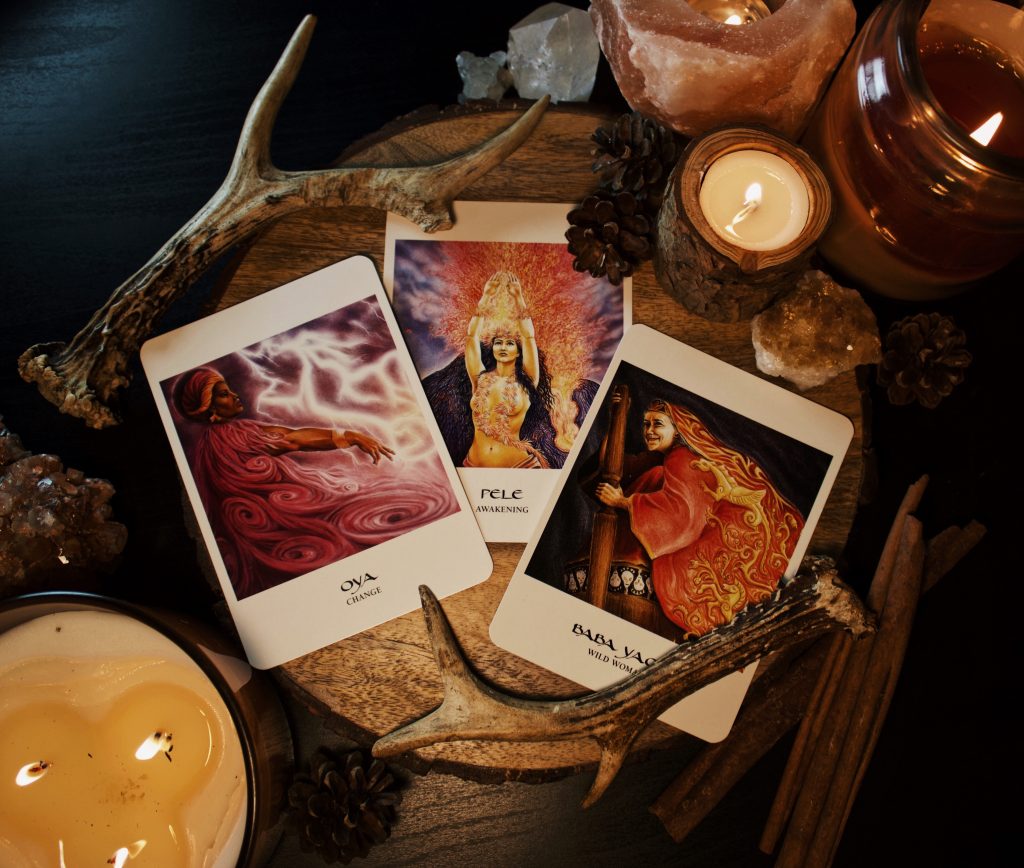
Synchronicity
However, I would be lying if I said that when I use tarot cards in this skeptical manner, I leave out the mystical dimension altogether. First of all because self-exploration, intuition, shadow work, journaling, etc.—all of these things are actually core components of my spiritual practice.
Secondly though, I also find myself allowing the more mystical framework of reality to leak into that of practical reality when using tarot and oracle cards simply because I think the practice works better that way. When I’m pulling my daily draw, or setting up a spread for a journaling session or whatever, I find it makes the experience much more enjoyable and insightful if I let myself believe (even just a little bit) that the cards I’ve chosen do actually carry the hint of a message from something greater than myself… That there are perhaps in some small way cosmic forces at play.
And then of course there are those incredible moments where even if I’m intending to use the cards for mainly psychological purposes, synchronicity pulls me right back into that magical mindset.
One of my favourite experiences of this was back when I was really just starting to learn tarot, and was using them to help me with the immense question of whether I should move overseas for grad school, taking advantage of an amazing opportunity, but leaving all of my family and friends behind for a year and stepping way outside of my comfort zone. As I was shuffling the cards, the Eight of Wands flew out the deck and fell to the ground. Not thinking anything of it, I put in back in the deck and continued shuffling (these days, if a card flies out, I always go with that one rather than putting it back in). Then when I pulled a card, it just so happened to be that same one: the Eight of Wands.
The Eight of Wands, I soon discovered, is a card that signifies travel (especially air travel), speed, and change. Then, if that wasn’t insane enough, the card that was pulled at the group meditation I attended the next afternoon was, you guessed it, the Eight of fucking Wands. I think it was pretty much then and there that I made the decision that I would go to Scotland, and it remains one of the best decisions I’ve ever made.
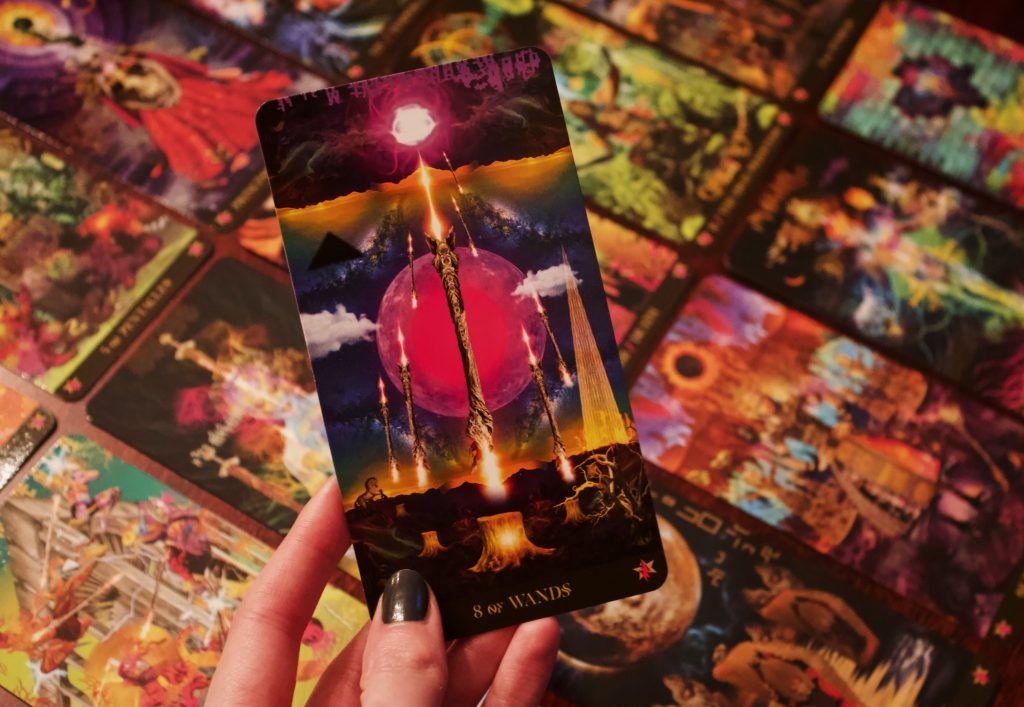
So, when crazy synchronistic things like this happen, or when the cards seem to reflect what’s going on with me wayyyy too accurately, it’s hard not to get pulled into the mystical, “woo woo” side of things. In truth, I welcome these moments, because they can be catalysts for some pretty profound spiritual experiences where I feel as though everything in the cosmos is perfectly aligned, even if just for a brief second. And in these moments, the objective “truth” of it doesn’t really matter, because that’s not the point. The point is the experience.
So with that, let’s get into some of the ways that I use tarot as more of an intentional spiritual practice.
Witchy Tarot
1. Decision Making
In addition to using tarot as a tool for more “rational” decision making, I also use it as a means of asking for some kind of cosmic guidance—whether from myself, or from the difficult to define, all-encompassing Spirit. Sometimes, when I have an especially significant decision to make, or am feeling especially lost, I’ll turn to the cards for advice. Whether or not the answers I receive are really coming from within me, or from some external force, it helps to think of them as messages from the Universe.
Usually when reading for major life questions, I’ll do slightly more elaborate spreads (though never too big, I rarely go beyond 5-7 cards), and then journal at length about what kind of messages might be coming through.
2. Monthly Guidance
Another way that I use tarot cards is to ask for general guidance from the Universe, to help me navigate through a particular cycle, usually corresponding with the moon phases. Without having any particular question in mind, I look to the cards not to predict what lies ahead, but rather, for inspiration and advice. Typically, these readings will be incorporated into lunar rituals, either at the new moon or the full moon (sometimes both).
In addition to doing my own readings, there are also some YouTubers who do these kinds of readings that I enjoy watching, and will take advice from. Sarah Vrba, for instance, combines tarot with astrology, and even though I’m far from being an expert in astrology, I never miss her Moon Magic episodes (or her monthly Scorpio readings!)
3. Ritual
Finally, the last way that I use tarot and oracle cards as a genuine “believer” is within the ritual context. Here, tarot cards are not mundane objects, but a conduit for Spirit, acting as a means of connecting with that which is beyond the ego, including the higher self, the interconnected cosmos, or whatever deities/spirits I may be working with (check out this post for how I work with deity as a pantheist).
When working with tarot cards in ritual, I’ll rarely have a particular spread planned out, and instead will pull however many cards feel right in the moment, taking a fluid, open-ended approach to interpretation.
Within the ritual context especially, tarot cards have the potential to be catalysts for powerful spiritual experiences, as here my skepticism is at its weakest. I won’t say that it disappears completely, even in ritual, because it is an important part of who I am. That said, the point of ritual is to quiet the intellect and escape from the prison of the rational mind so as to enter into a state of magical consciousness. In ritual then, it makes no sense for me to maintain a predominantly skeptical point of view in relation to tarot cards, or anything at all.
In the expansive state of ritual, anything goes, and everything is to be believed.
All this said though, just as I maintain a healthy does of magical thinking when I use tarot in practical, everyday contexts, so too do I maintain at least a sprinkling of skepticism in the more mystical uses.
The Dangers of Tarot
Okay maybe “dangers” isn’t the right word here. I don’t mean it in the sense of clutching one’s rosary beads while warning that tarot cards are of the devil.
The “danger” that I’m talking about here is, at least for me, falling into the trap of becoming too dependent on tarot and other forms of divination for answers, rather than figuring out things on ones own. While tarot can be a great tool for introspection and self-reflection, in my experience I’ve seen that it also runs the risk of becoming a crutch for indecisiveness.
As I mentioned before, I’m extremely indecisive. I struggle with things like choosing which restaurant to eat at or what colour to paint my nails, let alone things like whether I want to do a PhD or not, or what city I want to live in.
When I find myself having to make these massive decisions, the pressure of choice and fear of the unknown paralyzes me, rendering me incapable of making even the simplest of decisions in my daily life. When I’m in this state, I panic, and often look to tarot and other forms of divination for answers. Then you can find me frantically pulling card after card, or Googling every horoscope I can find, begging for guidance.
But of course, it never really comes.
This use of tarot isn’t inspirational, insightful, or remotely spiritual. It’s desperate. And if there’s one thing that I’ve learned about magic over the course of my journey so far, it’s that desperation doesn’t get you anywhere.
When I find myself in this wretched condition, I have to remind myself what witchcraft is truly all about for me: agency.
It’s about empowerment, personal strength, and the will to manifest. When I turn to tarot cards desperately seeking answers, I give up this agency. When I let myself become absolutely overwhelmed by the fear of the great unknown, begging for someone or something else to tell me what to do, I disempower myself. And that, for me, is not witchcraft.
This isn’t to say of course, that one has to be in control all the time. On the contrary, I believe that true agency exists in the relationships between us and the rest of the world, and there needs to be a balance of push and pull, give and take. It’s about knowing when to tighten the grip on life as much as it as about knowing when to loosen it, giving in to the flow of the Universe. Sometimes there’s a need to push forward, full steam ahead. Other times, it’s important to be able to sit back, relax, and let the Universe work its magic.
It’s ultimately about recognizing that there’s a delicate balance, or ongoing dialogue between self and cosmos. It’s a dance, really. And for me, a big part of witchcraft is about learning this dance—keeping time with the Universe, and absorbing it’s rhythms into my soul.
It’s about maintaining my own agency, while also being able to release control when need be. And this balance, this dance, is something that I’ve been learning to bring to my tarot practice as well.
Skeptic, believer, whatever, when tarot really works for me is when I recognize my own strength and embrace the power of my own mind, while remaining open to the patterns and flows of the Universe. Like with all of my spiritual practices, I get the most out of tarot when I remain open to possibility and to magic.
As always, thanks very much for reading!
If you’re interested in “skeptical tarot,” also check out this video by Áine Órga!
And if you’re interested in other forms of skeptical witchcraft I engage with, be sure to read my post on using crystals without necessarily believing in their healing properties!
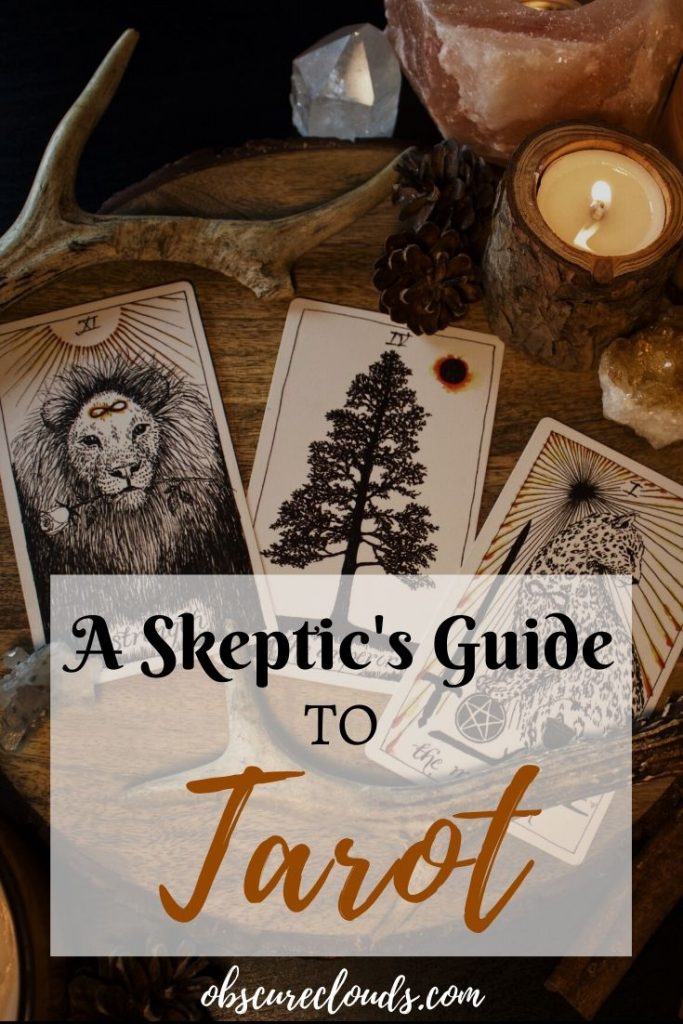
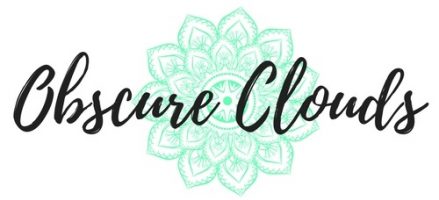
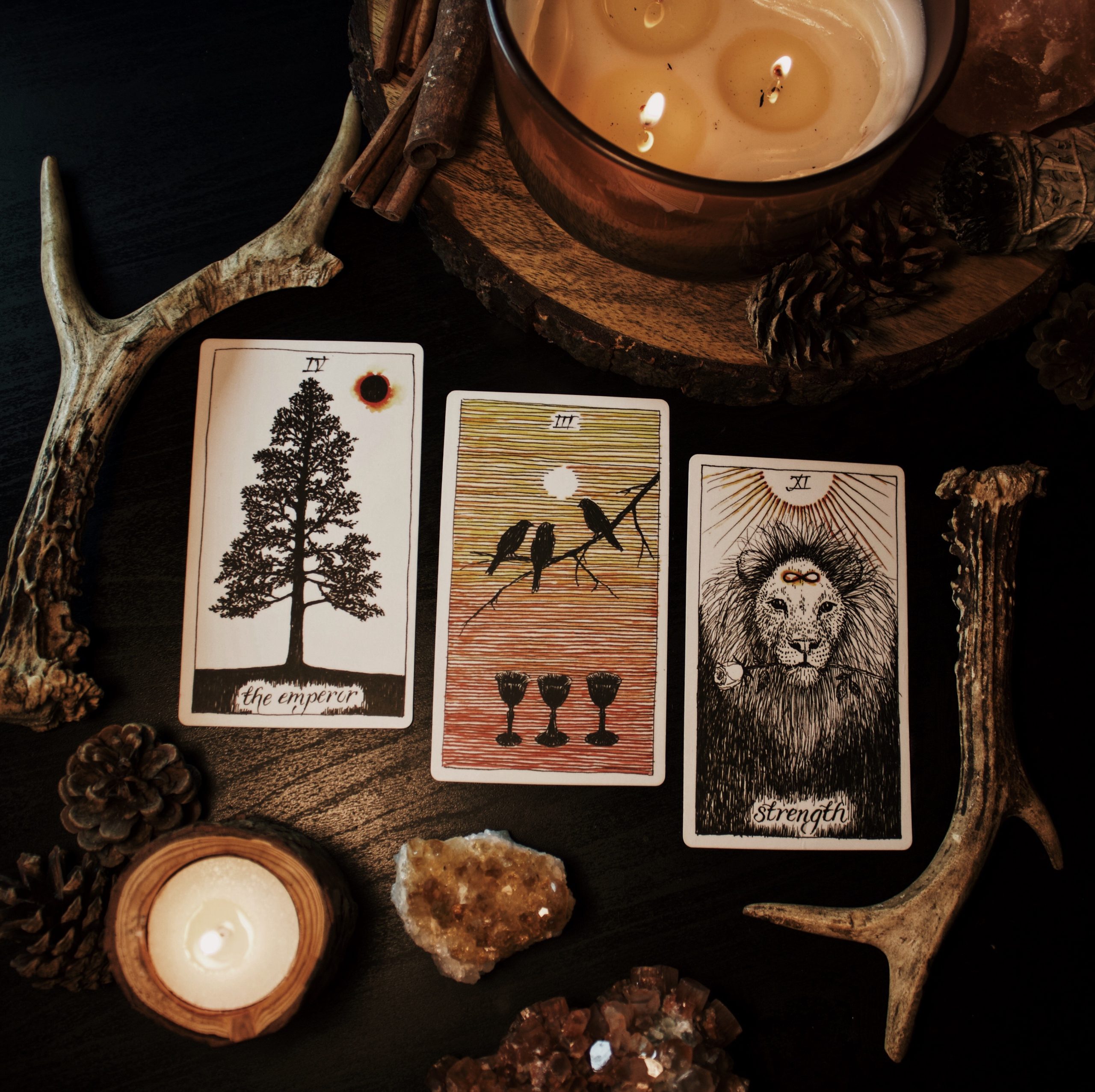

Perfect perfect perfect. Like so many others have commented, your thoughtful writing really helps to wrangle my own thoughts. Thank you.